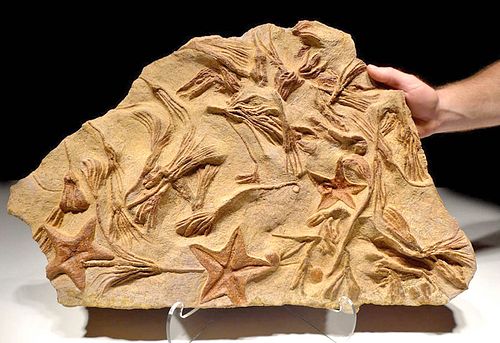Large Fossilized Starfish & Sea Lily Crinoids
Lot 140
About Seller
Artemis Fine Arts
686 S Taylor Ave, Ste 106
Louisville, CO 80027
United States
Selling antiquities, ancient and ethnographic art online since 1993, Artemis Gallery specializes in Classical Antiquities (Egyptian, Greek, Roman, Near Eastern), Asian, Pre-Columbian, African / Tribal / Oceanographic art. Our extensive inventory includes pottery, stone, metal, wood, glass and textil...Read more
Estimate:
$17,000 - $25,000
Absentee vs Live bid
Two ways to bid:
- Leave a max absentee bid and the platform will bid on your behalf up to your maximum bid during the live auction.
- Bid live during the auction and your bids will be submitted real-time to the auctioneer.
Bid Increments
| Price | Bid Increment |
|---|---|
| $0 | $25 |
| $300 | $50 |
| $1,000 | $100 |
| $2,000 | $250 |
| $5,000 | $500 |
| $10,000 | $1,000 |
| $20,000 | $2,500 |
| $50,000 | $5,000 |
| $100,000 | $10,000 |
| $200,000 | $20,000 |
About Auction
By Artemis Fine Arts
Oct 7, 2021
Set Reminder
2021-10-07 10:00:00
2021-10-07 10:00:00
America/New_York
Bidsquare
Bidsquare : Exceptional Antiquities Ethnographic Fine Art
https://www.bidsquare.com/auctions/artemis-gallery/exceptional-antiquities-ethnographic-fine-art-7537
Museum-worthy examples of Egyptian, Greek, Roman, Etruscan, Near Eastern, Far East / Asian, Pre-Columbian, African / Tribal, Oceanic, Native American, Spanish Colonial, Fossils, Ancient Jewelry, Fine / Visual Arts, so much more! Artemis Fine Arts info@artemisfinearts.com
Museum-worthy examples of Egyptian, Greek, Roman, Etruscan, Near Eastern, Far East / Asian, Pre-Columbian, African / Tribal, Oceanic, Native American, Spanish Colonial, Fossils, Ancient Jewelry, Fine / Visual Arts, so much more! Artemis Fine Arts info@artemisfinearts.com
- Lot Description
North Africa, Anti Atlas Mountains, Ktaoua formation, Ordovician, ca. 488 to 443 million years ago. A rare and concentrated natural stone matrix of starfish and crinoids (sea lilies) that died and fossilized together. This was once part of the prehistoric ocean floor, but professionally excavated and prepared, and each fossil is extremely three-dimensional, retaining their lifelike appearance, most show overlapping anatomy and multi-layer orientations. The matrix is all natural, only prepared to reveal the fossils; they are not arranged or composites of multiple pieces! This collection of ancient sea life is large and unforgettable; a visually impacting specimen of a mass extinction of various co-existing echinoderm forms. For the ultimate commercial or residential interior design application or for a public museum exhibit, this is the finest scientific grade showing of a rare and intriguing example of some of the earliest complex marine creatures on our planet. Sizes of star fish: 4.5" L (11.4 cm) to 5" L (12.7 cm); matrix: 26" L x 16" W (66 cm x 40.6 cm)
Despite this plant-like appearance and name "sea lily," crinoids are sea creatures that are related to starfish and sea urchins. These crinoids are of the form that attached themselves to the sea floor using a long stalk or anchor, which you can see preserved in several of the examples here. In life, these crinoids had a mouth on their top surface surrounded by feeding arms, giving them a waving, moving effect even here, frozen in stone. Many species of crinoids continue to live today, but during the Silurian period, they were much more abundant - the Silurian saw an explosion of life in the sea, and these animals would have been vibrant parts of that newly diverse ecosystem, probably brightly colored if modern sea lilies are anything to go by. Complete star fish are a rare occurrence in the fossil record, due to their skeletal composition that separates during decomposition. Dating back to nearly a half a billion years ago during the Ordovician Period, this amazing natural group fossil presents a mass extinction event! During this era, about 100 times as many meteorites struck the Earth per year, compared with today, and 2 such collisions in the Devonian and Permian and caused the demise of many echinoderm species, but some crinoids and starfish survived and rapidly diversified in a short span of 60 million years!
This piece has been searched against the Art Loss Register database and has been cleared. The Art Loss Register maintains the world's largest database of stolen art, collectibles, and antiques.
Provenance: ex-private French collection
All items legal to buy/sell under U.S. Statute covering cultural patrimony Code 2600, CHAPTER 14, and are guaranteed to be as described or your money back.
A Certificate of Authenticity will accompany all winning bids.
PLEASE NOTE: Due to recent increases of shipments being seized by Australian & German customs (even for items with pre-UNESCO provenance), we will no longer ship most antiquities and ancient Chinese art to Australia & Germany. For categories of items that are acceptable to ship to Australia or Germany, please contact us directly or work with your local customs brokerage firm.
Display stands not described as included/custom in the item description are for photography purposes only and will not be included with the item upon shipping.
#167896Minor repairs but no restoration. Natural group found as shown with no assembly!Condition
- Shipping Info
-
All shipping is handled in-house for your convenience. Your invoice from Artemis Gallery will include shipping calculation instructions. If in doubt, please inquire BEFORE bidding for estimated shipping costs for individual items.
-
- Buyer's Premium



 EUR
EUR CAD
CAD AUD
AUD GBP
GBP MXN
MXN HKD
HKD CNY
CNY MYR
MYR SEK
SEK SGD
SGD CHF
CHF THB
THB
















